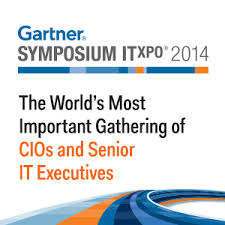 Gartner Symposium/ITExpo is under way in Orlando. As always, their IT experts have identified what they believe to be the top-ten information technology trends for the year ahead. Strategic technology trends are defined as having potentially significant impact on organisations in the next three years. Here is a summary of the trends:
Gartner Symposium/ITExpo is under way in Orlando. As always, their IT experts have identified what they believe to be the top-ten information technology trends for the year ahead. Strategic technology trends are defined as having potentially significant impact on organisations in the next three years. Here is a summary of the trends:
1. Computing Everywhere
With the continued advancement in smart-phone technology, Gartner assesses that an increased emphasis on serving the needs of the mobile user in diverse contexts and environments, as opposed to focusing on devices alone. Gartner posits that smart-phones and wearable devices are part of a broader computing offering to include connected screens in the workplace and in public spaces. User experience design will be of critical importance.
2. The Internet of Things (IoT)
The Internet of Things will continue to expand, propelled by the ubiquity of user-oriented computing. Gartner posits that this will be replicated both in industrial and in operational contexts, as it will be the focus of digital business products and processes. Embedding technology more deeply will create touch points for users everywhere. This will form the foundation of digital business.
3. 3D Printing
The cost of 3D printing will decrease in the next three years, leading to rapid growth of the market for these low-cost machines. Industrial use will also continue its rapid expansion. Gartner highlights that expansion will be especially great in industrial, biomedical and consumer applications, highlighting the extent to which this trend is real, proving that 3D printing is a viable and cost-effective way to reduce costs through improved designs, streamlined prototyping and short-run manufacturing.
4. Advanced, Pervasive, Invisible Analytics
Analytics will continue to advance due to the Internet of things and the embedded devices that trend will continue to foster. Vast pools of structured and unstructured data inside and outside organizations will continue to be generated. Gartner points out that every app will need to be an analytic app. The analysis also concludes that big questions and big answers are more important than big data.
5. Context-Rich Systems
Embedded intelligence that is ubiquitous combined with pervasive analytics will foster the development of systems that are alert and responsive to surroundings. Gartner highlights that context-aware security is an early application of this trend, but that others will emerge.
6. Smart Machines
Analytics combined with an understanding of context will usher in smart machines. Advanced algorithms will lead to systems that learn for themselves and act upon those learning’s. Gartner notes that machine helpers will continue to evolve from the existing prototypes for autonomous vehicles, advanced robots, virtual personal assistants and smart advisors. The analysis goes on to speculate that the smart machine era will be the most disruptive in the history of IT.
7. Cloud/Client Architecture
Mobile computing and cloud computing continue to converge and lead to the growth of centrally coordinated applications that can be delivered to any device. Gartner notes that cloud computing is the foundation of elastically scalable, self-service computing for both internally and externally facing applications. Apps that use intelligence and storage of client device effectively will benefit from lowering bandwidth costs, coordination and management will be based on the cloud. The analysis goes on to note that over time applications will evolve to support simultaneous use of multiple devices. In the future, games and enterprise applications alike will use multiple screens and exploit wearable’s and other devices to deliver an enhanced experience.
8. Software-Defined Infrastructure and Applications
Agile development methods for programming of everything from infrastructure basics to applications is essential to enable organisations to deliver the flexibility required to make the digital business work. Software defined networking, storage, data centres and security are maturing. Application programming interface (API) calls render cloud services software configurable, and applications have rich APIs to access their function and content programmatically. Gartner notes that in order to deal with the rapidly changing demands of digital business with demand shifts both up and down require computing to move away from static to dynamic models.
9. Web-Scale IT
Gartner notes that more companies will think, act, and build applications and infrastructure in the same way that technology stalwarts like Amazon, Google, and Facebook do. There will be an evolution toward web-scale IT as commercial hardware platforms embrace the new models and cloud-optimised and software-defined methods become mainstream. Gartner notes that the marriage of development and operations in a coordinated way (referred to as DevOps) is the first step towards the web-scale IT.
10. Risk-Based Security and Self-Protection
Lastly, the analysis concludes that security will remain an important consideration through this evolution toward the digital future, but it should not be so heavy-handed as to impede progress. As many companies have recognized that 100 percent security solutions are not feasible, this will become more mainstream, and more sophisticated methods of risk assessment and risk mitigation from a process and tool perspective will be implemented. Gartner notes that perimeter defence will be broadly recognized as inadequate, and multi-faceted approaches will be devised. Security aware application design, dynamic and static application security testing, and runtime application self-protection, combined with active context-aware and adaptive access controls will all be necessary.



